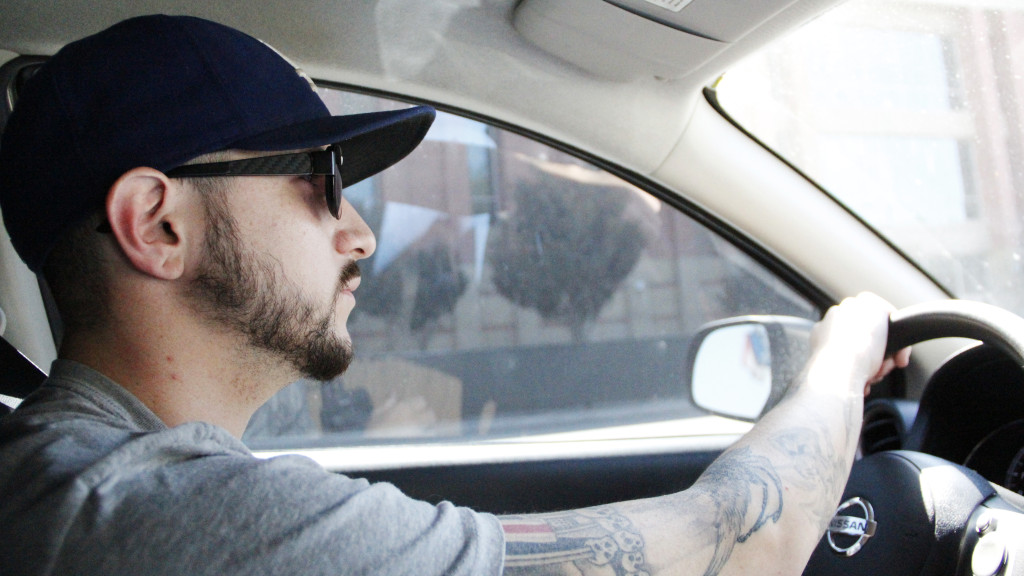Refueling the car every other day, working seven days a week, shuttling back and forth deep in the concrete jungle, is the kind of life Sergio Sanjurjo gets along with every single day. And he loves every second of it.
Sanjurjo, 25, has been driving for UberX in Los Angeles for five months. Along with doing two other jobs — property manager and marketing promotion— he would be lucky to have five hours to sleep everyday.
“Bills and prices of everything is getting higher, so the only way to get ahead in life is you gotta hustle hustle hustle,” Sanjurjo said, laughing. His main goal is to make enough money within ten years and retire by 35.
His weekly revenue from driving 30 hours a week is $950. According to Uber’s 80-20 split policy, he gets $760. “Whatever you make, you get 80%,” Sanjurjo said, “so it would be worth driving.”
Subtracting gas bill $100, car maintenance fee $20, iPhone rental fee $10 (Uber rents an iPhone to each driver to connect them to the APP and block incoming calls) and insurance $30 from $760, he makes a weekly income of about $600. “You can’t complain about that,” He smiled and said, “now your car is working for you instead of you working for a car.”
Sanjurjo enjoys being an Uber driver most. Not only earning double what he made at a nine-to-five-job, but the sense of making money for himself instead of for somebody else makes him happy. “Different from punching clock everyday, I come and go as I please,” he said.
Being an Uber driver also makes him proud. Some customers come to his car and complain how expensive and smelly the taxies are, how rude the taxi drivers are, and meanwhile express how much they enjoy taking Uber.
But a recent UberX fares slash by 25% makes Sanjurjo feel the sting. Sanjurio ups his driving time by ten hours per week just to make what he was originally making.
In order to get more rides, he has to keep an eye on the hotspot map showing where all the Uber drivers are, trying to drive further out to avoid a bunch of drivers near him. He also has to stay out longer to pick up people further away where he would not like to be originally.
Especially in traffic, the cost remains the same while the revenue seriously drops. He could be stuck for more than an hour making barely any money. “Driving in traffic is not fun,” Sanjurjo said.
Sanjurjo always chooses not to drive in traffic. He gets off early, utilizes his day and goes home early before rush hour.
Cutting the price is not the only way Uber leverages supply and demand principles. Actually, Uber is using dynamic pricing — raising prices when the demand is high, cutting prices when the demand is low. As MIT professor Yossi Sheffi puts it, it’s the “science of squeezing every possible dollar from customers.”
During a snowstorm in New York last December, for instance, UberX gouged the price 8.25 times the normal amount. But high risk always comes along with high reward. As James Surowiecki writes in In Praise of Efficient Price Gouging, “the reality is that the times when people most want a ride are also the times when it’s most annoying and, often, most risky to drive.”
For an Uber driver like Sanjurjo in L.A., where snowstorms never happen, surge pricing during times of high demand is the best thing that could happen. “Thanks to the surge pricing strategy,” he said, “it makes me some really good money.” He once made $200 on a normally $40 ride.
The surge pricing is short lived. More often, he deals with annoying cancellations. “It’s irritating when you are on your half way to pick somebody up and they just cancel on you at the last minute,” Sanjurjo said.
Uber’s cancellation policy tries to minimize the hurt by charging a cancellation fee if people cancel rides after five minutes. But any cancellation within the five minutes costs drivers’ money. The unpleasant episode, happening three or four times a day, costs Sanjurjo three or four full gallon of gas.
Sanjurjo’s biggest concern right now is whether decision makers in Sacramento will ban Uber in California. He doesn’t want to lose his favorite job. “I hope they can see that a lot of people make a good living on this and a lot of consumers enjoy it,” he signed.
After topping off his car, Sanjurjo turns on the engine and releases the brake. He and his car blends into the armored concrete and steel.

Leave a Reply
You must be logged in to post a comment.